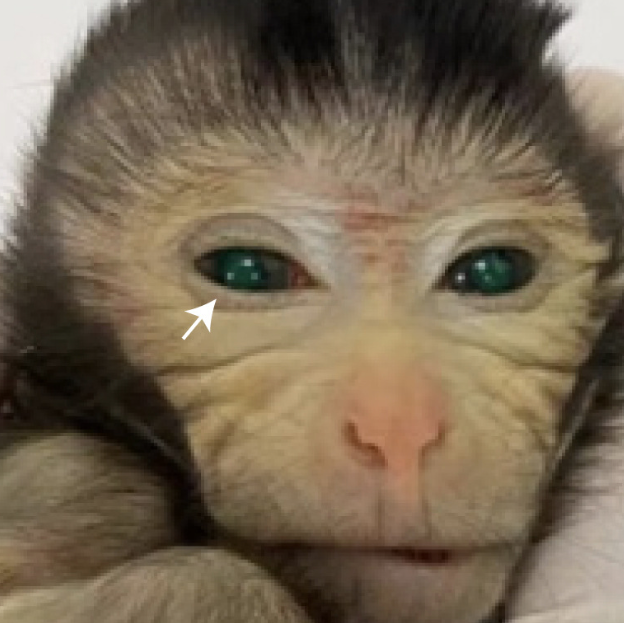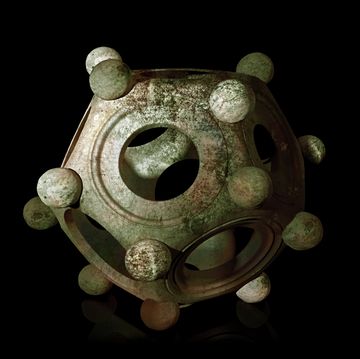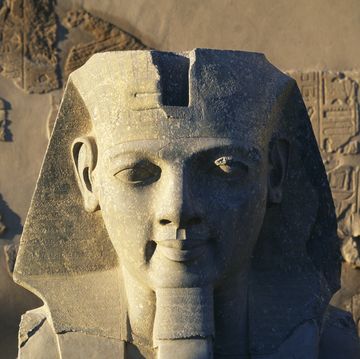- Chinese researchers crafted the first chimeric primate with two distinct sets of DNA.
- The monkey, which lived for 10 days after a live birth, was genetically modified to track stem cell growth.
- Researchers used a fluorescent green protein to distinguish tissue originating from donor stem cells.
Chinese researchers spliced together a monkey embryo with two distinct sets of DNA to create what is known as a chimera. And as if to make sure everyone would take notice when it was born, they added in a fluorescent green protein to distinguish tissue derived from donor stem cells.
Oh, we’ve taken notice.
In a study published in the journal Cell, the research team announced the creation of the first chimeric primate—in this case, a crab-eating macaque. This is yet another step toward genetically engineering animals that more closely resemble humans.
Creating a chimeric monkey required two genetically unique sets of embryos from the same species to be genetically spliced together before implantation in a womb and, eventually, a live birth. Stem cell lines from a seven-day-old embryo were injected into embryos that were either four or five days old—the later of which were infused with a green fluorescent protein for tracking purposes. The chimeric embryos were then implanted into 40 female macaques, which resulted in 12 pregnancies and six live births. But only one live monkey had the genetic distribution researchers were hoping for. Unfortunately, that monkey didn't live long, and was put down after 10 days due to respiratory failure and hypothermia.
In its short life, however, it shared a wealth of information with researchers. Most telling was the high donor cell contribution—up to 90 percent of the donor cells were eventually incorporated into the monkey. “It is encouraging that our live birth monkey chimera had a big contribution (of stem cells) to the brain, suggesting that indeed this approach should be valuable for modeling neurodegenerative diseases,” said Miguel Esteban, study co-author from the Guangzhou Institute of Biomedicine and Health, according to CNN.
Chimeric mice have been subjects of research since the 1960s. But studying chimeric monkeys will, hopefully, help us to better understand how diseases interact in humans. Still, there’s a long way to go before the tool becomes useful in people.
“This is an important study, but I wouldn’t consider it’s a breakthrough as the chimeras generated are not viable,” Jun Wu, an associate professor in molecular biology at the University of Texas Southern Medical Center, told CNN.
The surviving monkey displayed an average of 67 percent of donor stem cells across 26 different tissue types. “This is a long-sought goal in the field,” says Zhen Liu, senior author from the Chinese Academy of Sciences, according to The Independent. “This work could help us to generate more precise monkey models for studying neurological diseases was well as for other biomedicine studies.”
While a 10-day lifespan for a monkey isn’t ideal, study authors believe this is the start. “Our results have major implications for the study of primate naive pluripotency and genetic engineering of non-human primates,” they wrote.
More fluorescent green monkeys may be on the way.
Tim Newcomb is a journalist based in the Pacific Northwest. He covers stadiums, sneakers, gear, infrastructure, and more for a variety of publications, including Popular Mechanics. His favorite interviews have included sit-downs with Roger Federer in Switzerland, Kobe Bryant in Los Angeles, and Tinker Hatfield in Portland.













